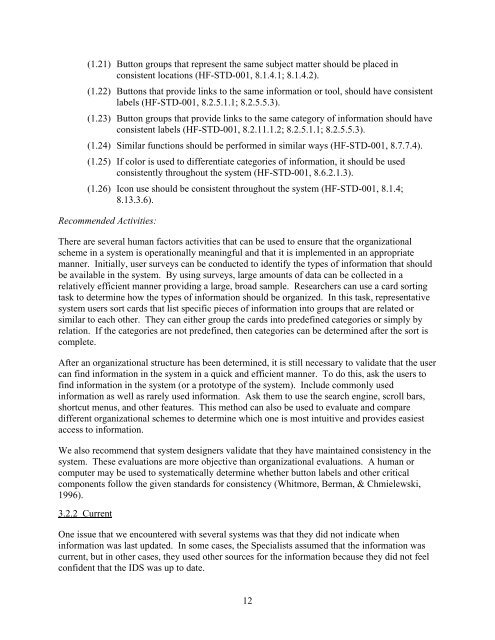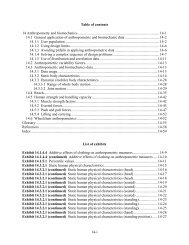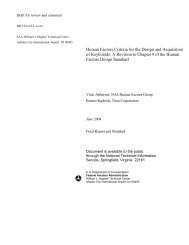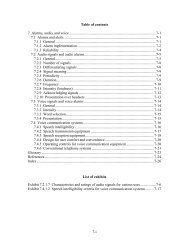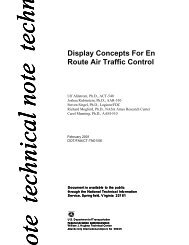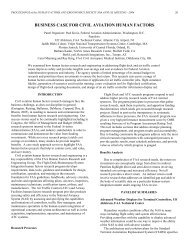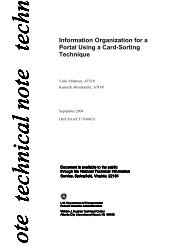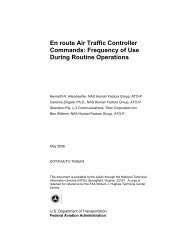Design of information Display Systems for Air Traffic Control - FAA
Design of information Display Systems for Air Traffic Control - FAA
Design of information Display Systems for Air Traffic Control - FAA
You also want an ePaper? Increase the reach of your titles
YUMPU automatically turns print PDFs into web optimized ePapers that Google loves.
(1.21) Button groups that represent the same subject matter should be placed in<br />
consistent locations (HF-STD-001, 8.1.4.1; 8.1.4.2).<br />
(1.22) Buttons that provide links to the same <strong>in<strong>for</strong>mation</strong> or tool, should have consistent<br />
labels (HF-STD-001, 8.2.5.1.1; 8.2.5.5.3).<br />
(1.23) Button groups that provide links to the same category <strong>of</strong> <strong>in<strong>for</strong>mation</strong> should have<br />
consistent labels (HF-STD-001, 8.2.11.1.2; 8.2.5.1.1; 8.2.5.5.3).<br />
(1.24) Similar functions should be per<strong>for</strong>med in similar ways (HF-STD-001, 8.7.7.4).<br />
(1.25) If color is used to differentiate categories <strong>of</strong> <strong>in<strong>for</strong>mation</strong>, it should be used<br />
consistently throughout the system (HF-STD-001, 8.6.2.1.3).<br />
(1.26) Icon use should be consistent throughout the system (HF-STD-001, 8.1.4;<br />
8.13.3.6).<br />
Recommended Activities:<br />
There are several human factors activities that can be used to ensure that the organizational<br />
scheme in a system is operationally meaningful and that it is implemented in an appropriate<br />
manner. Initially, user surveys can be conducted to identify the types <strong>of</strong> <strong>in<strong>for</strong>mation</strong> that should<br />
be available in the system. By using surveys, large amounts <strong>of</strong> data can be collected in a<br />
relatively efficient manner providing a large, broad sample. Researchers can use a card sorting<br />
task to determine how the types <strong>of</strong> <strong>in<strong>for</strong>mation</strong> should be organized. In this task, representative<br />
system users sort cards that list specific pieces <strong>of</strong> <strong>in<strong>for</strong>mation</strong> into groups that are related or<br />
similar to each other. They can either group the cards into predefined categories or simply by<br />
relation. If the categories are not predefined, then categories can be determined after the sort is<br />
complete.<br />
After an organizational structure has been determined, it is still necessary to validate that the user<br />
can find <strong>in<strong>for</strong>mation</strong> in the system in a quick and efficient manner. To do this, ask the users to<br />
find <strong>in<strong>for</strong>mation</strong> in the system (or a prototype <strong>of</strong> the system). Include commonly used<br />
<strong>in<strong>for</strong>mation</strong> as well as rarely used <strong>in<strong>for</strong>mation</strong>. Ask them to use the search engine, scroll bars,<br />
shortcut menus, and other features. This method can also be used to evaluate and compare<br />
different organizational schemes to determine which one is most intuitive and provides easiest<br />
access to <strong>in<strong>for</strong>mation</strong>.<br />
We also recommend that system designers validate that they have maintained consistency in the<br />
system. These evaluations are more objective than organizational evaluations. A human or<br />
computer may be used to systematically determine whether button labels and other critical<br />
components follow the given standards <strong>for</strong> consistency (Whitmore, Berman, & Chmielewski,<br />
1996).<br />
3.2.2 Current<br />
One issue that we encountered with several systems was that they did not indicate when<br />
<strong>in<strong>for</strong>mation</strong> was last updated. In some cases, the Specialists assumed that the <strong>in<strong>for</strong>mation</strong> was<br />
current, but in other cases, they used other sources <strong>for</strong> the <strong>in<strong>for</strong>mation</strong> because they did not feel<br />
confident that the IDS was up to date.<br />
12


